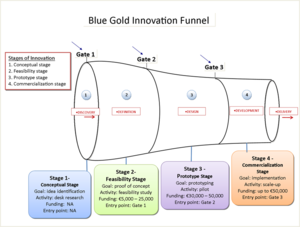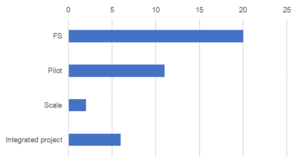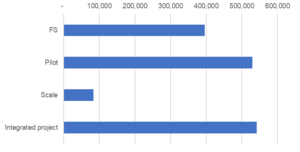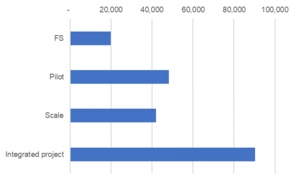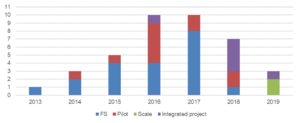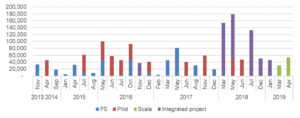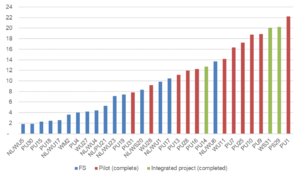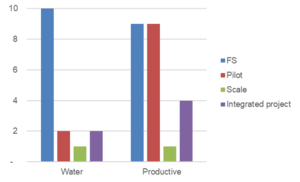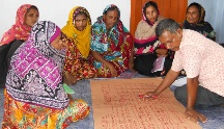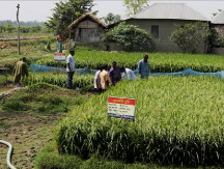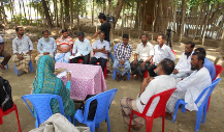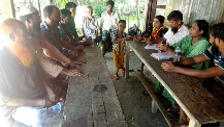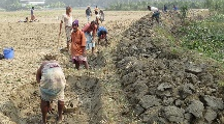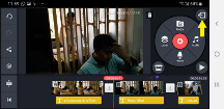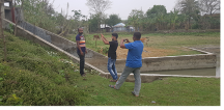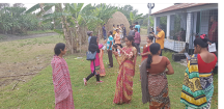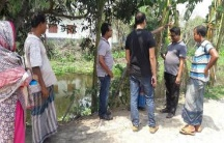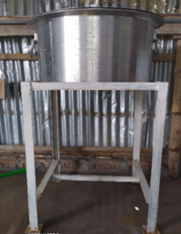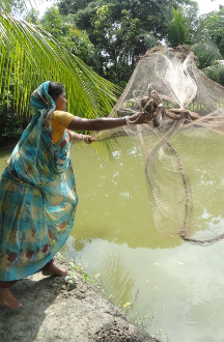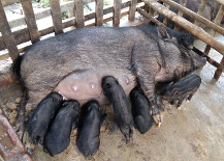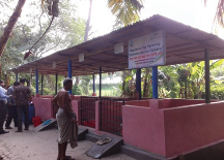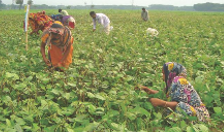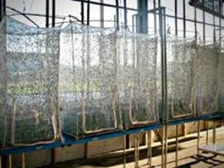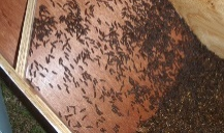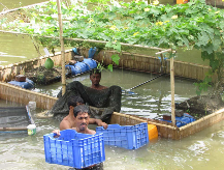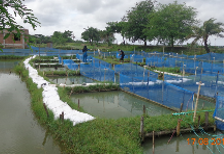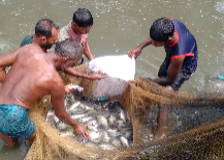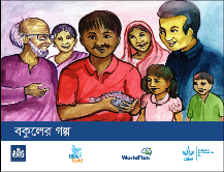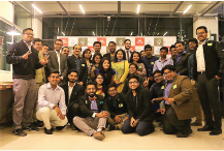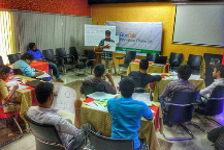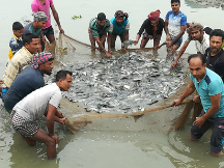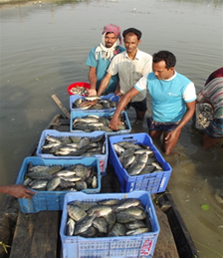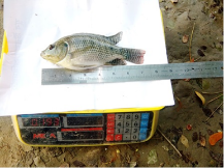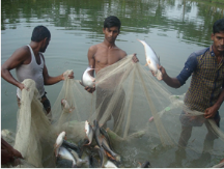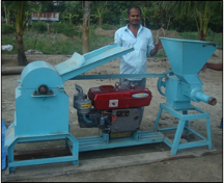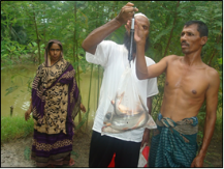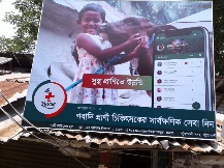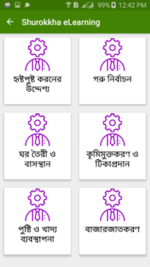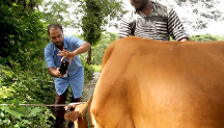Views
Actions
Section H innovation fund projects
This article is part of the articles on Section H - Innovation fund, for an overview see Section H - Innovation Fund.
| This is the section H of Blue Gold Program report |
| Blue Gold Innovation Fund (BGIF) |
|---|
| Section H contains: |
| Summary |
| Introduction |
| » Project overview « |
| Lessons learnt |
| Appendices |
In this article we will analyse the figures provided in the following high-level summary table:
| # of BGIF projects per type | Total EUR allocated | Average project size (EUR) | % of total EUR allocated | |
| Feasibility study | 20 | 395,774 | 19,789 | 20% |
| Pilot | 11 | 529,631 | 48,148 | 26% |
| Scale | 2 | 83,787 | 41,893 | 4% |
| Integrated project | 6 | 541,317 | 90,219 | 27% |
| Other | 3 | 464,770 | 154,923 | 23% |
| TOTAL | 42 | 2,015,279 | 47,983 | 100% |
Project types and the innovation tunnel[edit | edit source]
Originally, the idea was to let projects evolve through a feasibility, pilot and scaling cycle. The Innovation Funnel approach starts with a broad range of innovation proposals and gradually refines and selects from among them, creating a handful of innovative development projects that can be pushed to completion and introduction within the Blue Gold program. This notion can be illustrated as a converging funnel (Figure 1). The goal of the Innovation Funnel is to create a portfolio of projects that will meet the Blue Gold program objectives, while applying the Innovation Fund resources strategically and ensuring that the selected innovations deliver on the objectives anticipated when the innovation proposal is approved. While a few did indeed follow this cycle, most projects started with feasibility stage but did not evolve further. Others started at pilot phase (having already demonstrated its effectiveness elsewhere) and some started as integrated projects. These integrated projects originated from calls for proposals (agriculture & ICT) where the budget ceiling was up EUR 133,000. Most projects are feasibility studies (20 out of 42). It is observed that few feasibility studies (FSs) made it to pilot stage (3 out of 20).
Two feasibility studies were brought to pilot scale by WMKIP, namely pumped drainage and water apps. So, five feasibility studies in total or 25% graduated to pilot phase. Eight pilot projects did not have a FS predecessor. There were three feasibility studies where the final report was not accepted, as the relevance to the Blue Gold Program and Bangladesh as a whole was insufficient. From the three projects, only two made it the final ‘Scale’ stage. However, integrated projects (6) are basically scale projects but skipped the feasibility study stage. Integrated projects are actually a combination of pilot and scale stage, and were required to be proof that they had already passed a feasibility study stage.
In the rest of this report, the category ‘Other’ is not analysed as the results are not fully related to innovation outcomes[1].
Although there are more FS projects funded then pilot or integrated projects, total funds towards these last two types of projects is far more. This is important since the Innovation Fund ultimately aims at implementing innovations on the ground and not only studying the feasibility potential ideas.
Given that there were relatively more feasibility studies, the allocation per type of project shows that relatively speaking, integrated projects are the largest, followed by pilot and scale projects. FS size in EUR is about half of pilot and scale projects. Integrated projects are roughly 4 times the size of FS types, on average.
Now we take a chronological perspective, where, looking at the contract signing date, we can deduce a trend where at first mostly FS and pilot projects were contracted in 2013-2017. In 2018, larger and integrated projects were mostly signed. This makes sense, since Innovation Fund moved from funding feasibility studies into funding the implementation of pilot, scale and integrated projects.
The graph below depicts the same contracts but now breaks it down into months of each year and the cumulative amounts of signed contract amounts in EUR per month in the 2013-2019 period.
In the lesson learnt section this report reflects on how the fund re-oriented its focus towards demand led initiatives and involved field-based technical experts of blue gold in the appraisal of BGIF project proposals and subsequent implementation since 2017.
In terms of duration[2], feasibility studies have on average taken half a year to complete (5.6 months) and pilot and integrated projects take 1 to 1.5 years. Note that this only includes completed projects, as of October 2019.
Table 2: Average duration of BGIF projects, per type
| Type | # | Average duration in months |
| FS[3] | 16 | 5.6 |
| Pilot (completed) | 11 | 14.5 |
| Integrated project (completed) | 1 | 12.7 |
In some cases, total project duration exceeded their original allocated schedules. This was mostly due to revising final reports.
Projects in the Water Management Fund and Productive Sector Fund[edit | edit source]
The BGIF features two funding windows; the water fund and the productive sector fund.
The water fund is closely connected with water management activities in the Blue Gold Program. It aims to involve representatives of all community stakeholders (eg farmers, fishermen, landowners, landless, etc.) working through water management organisations (WMOs) in partnership with government, NGOs and the private sector to manage water to meet agricultural requirements. Interventions include the rehabilitation of flood embankments, plus associated structures such as sluices to convey water across the embankment, to reduce the risk of loss of lives and crops; maintenance of main khals to remove water from the fields, or to store water for supplementary irrigation; operation of sluices to drain excess water or to introduce fresh water in times of shortage. In-polder water management demonstration schemes are set up to enable collective action to ensure timely drainage, synchronisation of cropping patterns and improved agricultural production strategies. In-polder water management helps establish resilient, productive and diverse cropping systems; and the capacity to manage that into the future.
The productive sector fund aims to enable the farm households to enhance their productivity, be it for home consumption or sales; to make use of additional availability of land and opportunities for different cropping systems; and to pursue better services from government and private agencies; and better deals from input suppliers and bulk buyers. Market system development is aimed for through Farmer Field Schools (FFS), which introduce concepts as farming as a business and market orientation, but also development activities which strengthen the capacity of and linkages with other actors such as input suppliers.
All BGIF projects were funded by either of these two windows, depending on whether the project outcomes were aligned with the goals of the water management fund or the productive sector fund.
In this sub-section we look at which projects were funded by these two funding windows and what outcomes these projects achieved, and what lessons were learned from a fund management perspective.
First, we look at the total number of projects funded by the two windows, see Figure 10 below. Both the Water and Productive fund have funded many feasibility studies (10 and 9, respectively), but the Water Fund has far fewer pilot projects (2 versus 9), scale (1 versus 1) and integrated projects (2 versus 4).
Size wise, the Water Fund has about half of its funds allocated to FS, Pilot, Scale and Integrated projects compared to the Productive Fund[4].
The next section will delve into individual projects and review some of the main outcomes and lessons learned, here we only look at those projects which implemented innovative project ideas – so feasibility studies are not subject of this review.
Water Management Fund projects:[edit | edit source]
| Community Based Integrated Water Management, FHRC:
The project served to test whether an alternative community based integrated approach to water, land and natural resources management could help communities address their priorities and improve returns under BGP. Some outputs: · Training main local stakeholders (WMG members) · Exchange visits (WMG in Polder 43/1E to and from WMG in P.29) · Enabling minor tertiary works to improve water storage/supply and drainage · Promoting low water demand dry season crops so that water is used more efficiently (assistance with seeds, advice on crops) · Vegetable cultivation in polybags was tested by 44 households and then spread. Brinjal, tomatoes and chillies were successfully grown for home consumption, enhancing nutrition. · Rice variety BRRIDhan 67 was demonstrated and gave yields 1.5 times that of usual varieties and was free from rust disease which was widespread in this dry season. Lessons learned: Starting with Participatory Action Plan Development and helping WMGs implement their plans builds trust and capacity but depends on a flexible response to WMG demands. It takes time to build trust and obtain government support, so a phased approach is needed. Forums of adjacent WMGs (cluster approach) bridged gaps between WMGs and enabled learning between pilot and other WMGs. Knowledge sharing encourages improved performance and healthy competition among WMGs. | |
| SWIFT, United Purpose (& SMKK)
The Sustainable Water Management through Indigenous Finance and Technology Research (SWIFT) project helped farmers to decide their priorities for small scale water infrastructure work, gather (in-kind) contributions from union parishad and the farmers themselves and finally obtain funds from government to implement these small works themselves. The project has gone through two phases (FS and Pilot) and is currently in the final Scale phase. Some highlights from the pilot phase project: · WMGs are taking leadership in resource mobilization, made a start with breaking the cycle of aid dependency from external donors which will positively support them to ensure sustainability of their activities. · WMGs came forward to take the lead on flood control and drainage infrastructure (FCDI) works to be implemented through mobilising resources from different sources by their own initiatives. · WMG members improved ownership for initiating FCDI works. · Mobilised resources value in BDT 6,56,864 against BDT 5,94,948 for 26 FCDI schemes. · Enhanced networking and linkages of skills between WMGs and Union Parishad Authorities, DAE and BWDB representatives. Phase III still ongoing, so further outcomes and lessons learned pending | |
| Accelerating Horizontal Learning in Blue Gold polders: ICT as force multiplier, MetaMeta (& JJS and Access Agriculture) final report (end Dec ’19 expected).
The horizonal learning project trained farmers to make videos and helped them capture their best-practise examples, which were subsequently shown to other farmers groups in the project area. Outputs: · Trained 27 UDC Members in video making & sharing · Trained 250 WMG Members in video making & sharing · Improved self confidence on some of the videomakers and view of improved personal development. Impact: behavioural change as the objective. 2nd nature to make and share good practises by farmers. Indications of direct impact through interviews CDFs & WMG member: adoption of dragon fruit & chicken rearing good practises by acquittances. Lessons learnt: more prices, longer trainings, more mentoring during shooting. | |
| Water Hyacinth, Khulna University (&WUR and BEDS)
‘Development of value-added products from water hyacinth to support alternative livelihoods and ecological resilience’ is implemented in Polder 25 (WMG at Thukra Bazar, Dumuria, Khulna) to address water hyacinth infestation problem in southwest coastal polders. Still ongoing, so outcomes and lessons learned pending |
Productive Sector Fund projects:[edit | edit source]
| Eco Pond, World Fish:
In the Ecopond approach small homestead ponds are used to create shade and shelter for fishes with simple materials which can be easily collected and maintained by women. The Ecopond project has shown that the participatory methods and tools used were effective to engage women actively in the program even with small numbers of staff. It has demonstrated that development of community groups, setting up of the Learning Centers, involvement of women leaders and linkages with the WMGs and other stakeholders along with training were useful. A total of 3,377 women owning around 4500 small ponds were involved and more than 80% were successful in generating income and receiving better nutrition from the small ponds. The Ecopond approach has been undertaken by other institutions too such as the CREL project of Winrock International who scaled-out the approach by working directly with more than 500 households near the Sundarbans. During the project, WordFish has developed a training manual, a video, a database and other articles and papers to promote upscaling. It has also acquired additional funds to keep on monitoring the Ecopond project in the BGP area up to June 2018 and upscale the project further in the coastal belt. Lessons learnt: · The Ecopond project approach works, i.e. developing women local service provider (LSP) and Lead Farmers worked for scaling the ecopond production system through effective engagement of women. · Engagement of women in small-scale aquaculture can increase women empowerment and household nutrition by increased consumption of small fishes at the household. · Families consumed almost all the fishes (93%) produced in the ecopond, ameliorating their daily nutrition. · To ensure quality breed or fingerlings of small native species in the time of stocking in the ecopond, as many of the small ponds dry up during dry season. | |
| Pig rearing pilot, Nice Foundation:
To improve the economic and social status of the pig-rearing community by investigating particular aspects of hygienic pig management and rearing: pigs' reproductive performance, their mortality rates, diseases and treatment, feeding practice, and marketing. The project trained 200 pig farmers (90% women) on hygienic practices in pig husbandry using the Farmer Field School (FFS) approach. Market linkages were established between service providers, farmers and traders. A pig demonstration farm was established as a learning model for pig farmers. Some lessons learned: · Pig manures can be used for bio-gas and organic fertilizer in agricultural field. · Pig farming can be accepted by local population, if they are hygienically and sensitively managed. · Scaling up difficult because of small community involved and remote markets. | |
| Increasing mungbean production of small farmers, JUST Farming:
The project intended to address two major challenges in the mungbean value chain: The project intended to address two major challenges in the mungbean value chain: 1) quality of produced mungbean is low and 2) volumes of farmers are not high enough to allow efficient marketing. A Production Hub (with an IT-system to support production management and quality control) was the solution that the project sought to implement. 200 small-scale mungbean producers signed contract agreements with Just Farming. 100 farmers harvested on average 218 kg. It was sold to JF on average at BDT 76 p/kg (improvement compared to previous year sale price of BDT 62 p/kg). The other 100 farmers lost their crop due to unfavourable weather conditions. Lesson learned: · Just Farming pilot had some extension success but ultimately failed in securing their own forward linkage, i.e. contracting with a mung processor prepared to pay a premium for mung cultivated along particular requirements of size (variety), cultivation practice (pest management), harvesting etc. · The selected IT-system was a standard package. It proved useful to manage a producer group in a ‘contracting’ situation thereby largely serving the needs of the lead firm. It was insufficiently flexible in its set-up to serve farmer needs though. | |
| IFCAS, Practical Action:
IFCAS (Integrated Floating Cage Aquaponics System) was found as a suitable option for resource poor people in vulnerable areas to get a quick return. 15 farming families of Satkhira district have practiced aqua-geoponics technology in canals and ponds and confirmed that the business case was profitable within two cycles. Major risks found were 1) presence of crab in the canal which can damage net, 2) water availability and security issues to protect the fish. Three things can be further improved: – 1) diversification of fish and vegetable species 2) rethink cage material and cost, 3) test such cases with access to commercial finance. Lessons learnt: · Pilot achieved breakeven in terms of costs and benefits. · Idea is good in waterlogged area, but limited replicability in rest of polder due to easier, and more lucrative options for farmers involved. | |
| Tilapia Feed, WorldFish (& WUR and CGIAR):
The new pond feed formulation resulted in 15% additional fish growth during the piloting phase and created tremendous interest among the tilapia farmers in the working areas. It also increased farming gross margin at high stocking density was nearly double with the new feed. However, due the regulatory restriction according to “Fish feed and Animal feed Act 2010” of government of Bangladesh, the commercial feed companies cannot follow the new composition. To address this policy barrier, WorldFish together with several fish feed companies organised a large-scale piloting for evidence together with DoF. The project could successfully demonstrate the benefit of using feed in doubling productivity of fish in the homestead and commercial ponds. This has created increased demand of tilapia feed in the southwest region, which has been reflected by the continued growth of the feed business by the local service providers and net production increase of tilapia from SW Bangladesh in contrast to rest of the country. For the semi-automatic feed millers the project could attract interest of “Single Spark”, a Dutch start-up company working on digital extension of fish and animal feed formulation by developing feed calculator. This company has now included formulation in their apps and is scaling in Bangladesh and Africa. The industrial collaboration with Dutch Feed Company, De Heus, continued to grow in areas of both research and market expansion in Bangladesh. | |
| BG Innovation Challenge, Social Business Youth Alliance (& YY Goshti):
The Blue Gold Innovation Challenge aimed at inspiring innovative business solutions to the various problems faced by the inhabitants of the BGP polder areas so that they can begin to support themselves independently and profitably. The project resulted in seven winning youngsters with innovative ideas and entrepreneurial ambitions. Four youngers started working on a prototype. Lessons learned: · Quality of submitted proposals to the BGIF were below the acceptable standard. It is perhaps too ambitious to expect that young people without any work or business experience (some still studying) can devote sufficient capacity and time to prepare and implement a project under BGIF on their own. · More efforts could have been stimulated from the start to let them form partnerships with well-established organisations and businesses in Bangladesh. | |
| Pen Culture, BSMRAU:
The seasonally waterlogged areas could potentiall[BM1] y be utilised for adoption of pen fish culture technology. The target fish to culture would preferably be the short-grown species like tilapia. The major carps may also be stocked as secondary fish species. The main benefit of the project was building awareness and knowledge of WMGs (and the rural communities as well) on productive utilization waterlogged beels for local livelihood improvement through adoption of pen fish culture. The production cycle in one area could not be completed due to water drainage as a result of re-excavation of a nearby khal under the Blue Gold Program (the success of the Amodkhali excavation, which reduced the waterlogging greatly, but located in the wrong location for this BGIF project). In addition, there intentional damage of nets prior to final harvesting that caused a huge number of fishes to escape. Lessons learnt: · Closer cooperation between water infrastructure team and those involved with BGIF project appraisal and monitoring · Implementation team of mostly senior team of professors does not work with very few operational staff for actual implementation on the ground. | |
| Pangush Farming, Innovision:
Using improved culture practice, Pangasius aquaculture in homestead ponds of 3 Upazilas of Patuakhali District resulted in increased fish production. The participating farmers used farm-made feed. The farmers also got a better farm gate price of Pangasius in comparison to capital city market price. Lessons learnt: · Feed quality, particularly protein content, was a major concern as the feed was produced from unidentified sources. Moreover, farmers' perception in pond management, specifically in feeding practices, resulted poor fish growth in some ponds. · Transportation in the local urban markets need strong infrastructure system. · The farmers need a strong backup linkage to continued fish or Pangasius farming practices in their ponds. | |
| Women Business Centres, United Purpose
Centres were designed to improve rural women’s access to services, income, and their position in agricultural value chains in rural areas. The Feasibility Stage was successful, women were trained and selected for the subsequent phase to set up profitable businesses and marketing services not usually available in the local rural setting (like scanning documents, printing pictures, etc) and selling some relevant products for women as well (like sanitary pads). However, the WBC quickly became regular micro retail-stores, selling eggs, cigarettes, some vegetables, etc like any other roadside shop. Lessons learnt include making sure that the local project manager fully understands the larger picture of the innovative idea and is coached by the head office. Due to high staff turnover at key positions for this project at United Purpose, the provided guidance was insufficient. | |
| Climate and market smart mungbean advisory services, CIMMYT
Xxx Still ongoing, so outcomes and lessons learned pending | |
| Breed identification and digital registry of cattle, mPower:
Objective: Livestock sector of Bangladesh is characterized by low cattle productivity compared to other countries. Although artificial insemination has been introduced for many years, there is no proper record of improvement in the genetic material of cattle breeds. Results: The project successfully developed digital cattle breed identification application and implemented in Dumuria of Khulna, Satkhira Sadar and Patuakhali Sadar Upazilas. 6,000 plus livestock farmers received improved livestock services which includes tele-veterinary, breed identification & AI recommendation and SMS based Advisory services with a very high satisfaction. Successfully developed AI Dashboard for DLS and AI service providing companies. 52 community livestock service providers have improved their technical knowledge and competency through digital E-Learning modules and videos. Lessons learnt: · Strong demand has been observed for tele-veterinary and breed identification services among farmers, local service providers as well as the community leaders. These digital services increased confidence and competency of service providers in delivering livestock treatment and advisory services to farmers. · Breed Identification service AI technicians find it easy to motivate farmers take right type of semen for their cattle. Farmers developed strong awareness on negative and long-term consequences of wrong type of semen use for AI. However, sometimes AI technicians did have recommend type of semen for the appropriate AI. · Although willingness to join Shurokkha tele-veterinary service among community service providers is quite strong, soliciting service with payment is limited to only complicated cases. | |
| Sack Farming, Practical Action
Still ongoing, so outcomes and lessons learned pending |
Fairs by GoB departments[edit | edit source]
In order to showcase successful innovations and promote the adoption of good practises, DAE and DoF have arranged a number of ‘Fairs’. BGIF supported three fairs, 2 from DAE and 1 DoF fair.
· DAE organized the fair at Yunus Ali khan Degree College Premise, Amtali, Barguna from 07-09th December, 2019. United Purpose with their project ‘Sustainable Water Management through Indigenous Finance and Technology’ and Practical Action with their project ‘Sustaining Sack Farming Practices through Agro-met Services in Coastal Polder Areas of Bangladesh’ participated in the fair.
· DoF organized a fair at Patuakhali District Fisheries Office premises from 20 to 22 July, 2019 . Innovision Agro Service Ltd. participated the fair with their project ‘Augmenting homestead Pangasius aquaculture productivity in three Upazillas of Patuakhali through community participation’.
Local farmers, WMG members, value chain actors participated the fair with great interest.
Table 3: BGIF fairs
| Location | Date | GoB Department | BGIF project |
| Patuakhali, ?? | 20-22 July 2019 | DoF | Pangasius (Innovision) |
| Patuakhali, Barguna | 7-9 Dec 2019 | DAE | SWIFT (UP) & Sack Farming (PA) |
These GoB initiated fairs indicate the enthusiasm by which some of the BGIF projects were received by government departments.
- ↑ Other’ category contracts are funded through the BGIF but whilst they were important for BGP objectives, they were not aimed at innovative approaches and are mostly works contracts, and not services.
- ↑ Duration has been calculated as the time in-between the signed contract (official start) and date of final report (official end).
- ↑ Does not include 3 feasibility studies that were cancelled.
- ↑ The Water Fund has funded a number of large ‘other’ category projects and when looking at total expenditure/allocation, the two funds are almost on par. In addition, many water projects were transferred to WMKIP of Deltares/IWM.
